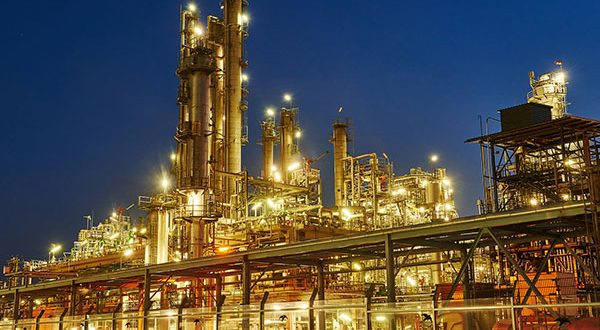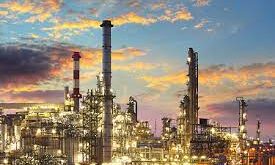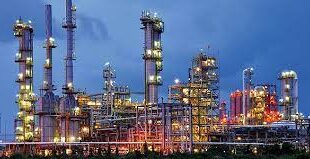Iran has decided to build more petrochemical plants in new petrochemical hubs in the next four years to produce more feedstock at the giant South Pars gas field in south of the country. a monthly affiliated to the Ministry of Petroleum reported.
According to the latest issue of Iran Petroleum monthly. Iran is currently producing at least 60 million tons a year of petrochemical products. while more than 60 petrochemical projects remain incomplete envisaged in the previous five-year economic development plans. Once these projects come online. Iran`s petrochemical production capacity will double.
The projects have been embarked by Iran`s National Petrochemical Company (NPC) which is an important wing of the country`s oil diplomacy.
Under the next administration of President Hassan Rouhani. Iranian petrochemical officials intend to produce more feedstock at the giant South Pars gas field as more petrochemical plants are to be built. The new plants are projected to be constructed in new petrochemical hubs.
Mahshahr is home to 21 petrochemical plants with a total capacity of 25.6 million tons a year and Assaluyeh is home to 13 petrochemical plants with an annual capacity of 24.3 million tons. They are Iran`s main petrochemical hubs.
Since development of industrial hubs is a key factor in the industrial development of countries. and favorable and sustainable development of petrochemical industry in these hubs hinges upon preparing general and specialized infrastructure. the NPC is studying potential petrochemical hubs within the framework of its development plan with a view to proximity to sources of feedstock. water and facilities for exporting petrochemicals.
Among the areas under study for petrochemical projects are Special Petrochemical Zone in Mahshahr. Parsian Energy Industry Site. Lavan Island. Qeshm Island. Jask and Chabahar.
Marzieh Shahdaei. CEO of NPC. said Iran`s petrochemical roadmap would require 36 new projects in the new hubs. These new projects would add 60 million tons to the country`s petrochemical output capacity. That would be the third jump in Iran`s petrochemical sector.
Future development of petrochemical industry will not be limited to Bandar Imam and Assaluyeh as four other hubs off Persian Gulf and the Sea of Oman would also see new projects.
Parsian Special Economic Zone in eastern Assaluyeh. Jask Free Zone located next to the Strait of Hormuz. Chabahar Free Zone and nearby Iranshahr Free Zone are the four hubs.
In addition to these four hubs. four mega-tone methanol and urea ammoniac projects with capacities above one million tons in Lavan and a number of GTP plants in the mainland are envisaged. Since natural gas will be available in abundance in the near future. the NPC intends to apply GTO and GTP technologies to produce olefin which is crucial to downstream industrial development.
Senior NPC managers say investments in the Persian Gulf and the Sea of Oman will continue. All Persian Gulf and Sea of Oman coasts have potential to become petrochemical hubs due to access to feedstock and high seas. The private sector is building new hubs in Chabahar. Jask and Parsian. Iran has already laid out a pipeline as far away as the Pakistani border for future transfer of gas. The pipeline has capacity to carry 105 mcm d of gas. Pakistan would be receiving 25 mcm d of gas. therefore. the pipeline would be able to supply more than 75 mcm d of gas to petrochemical plants in southeastern Iran.
Furthermore. railroads in southeastern Iran and Chabahar Free Zone could be attractive for investors. Required infrastructure is also envisaged to be erected in Jask. Parsian and Lavan.
In the near future. natural gas will become the main feedstock for Iran`s petrochemical plants because ethane would not be easily accessible. Given Iran`s huge gas deposits. it will be one of the most reliable countries for investment in petrochemical projects.
Iran enjoys unique opportunities for petrochemical development thanks to its access to liquid and gas feedstock required for this industry. Iran holds the largest hydrocarbon (oil and gas) reserves in the world. There are also other advantages in Iran like long sea borders in the Persian Gulf and the Sea of Oman that could save foreign investors big sums in shipping products to target markets.
Educated and experienced youth and the skills developed by designing. engineering. construction and installation companies are among other advantages in Iran. Above all. with a population of more than 80 million and easy access to important consumer markets like Central Asia. Iraq. India and China. Iran would be attractive enough for potential investors. Add to this Iran`s free trade and special zones that would allow foreign investors to invest alone and be exempted from taxes and duties for 10 years.
`Iran envisages more than 105 mcm d of methane. 2.8 million tons a year of ethane. 2.1 million tons a year of propane. butane and liquefied petroleum gas as well as four million tons a year of naphtha as feedstock for its new petrochemical projects in the future. Domestic and foreign companies that would operate these projects will have no problem with feedstock.` Shahdaei said.
Petrochemical industry consumes huge amounts of water and energy and many petrochemical units are already facing water shortages and decline in exports. Therefore. development of infrastructure in new hubs could be a top priority for petrochemical sector. Iran aims to become the top petrochemical producer in the region by 2025and is currently exporting petrochemicals to more than 40 countries. Iran`s landmark nuclear deal with six world powers and the ensuing lifting of sanctions have provided suitable conditions for Iran to benefit from 400-million-strong markets in neighboring countries. Given Iran`s geopolitical position. these markets are highly significant. Iran is instrumental in meeting basic needs in other countries. After new development projects become operational by 2020. Iran`s share of petrochemical production in the Middle East region would reach 41%. Under Iran`s 6th Five-Year Economic Development Plan. 55 million tons will be added to production capacity. while 33 petrochemical plants plus eight supply chains for the production of 60 types of products are planned.
Over the past 10 years. the pace of provision of infrastructure for investment in the petrochemical industry has been slowed down by sanctions. The Iranian government has tried its best to make up for losses. Petrochemical industry is key to increasing profitability and boosting Iran`s status in economic ties in the region. The industry must be paid attention to more seriously as there are powerful rivals. In addition to gaining revenues from petrochemical industries. jobs will be created and welfare will be provided to underprivileged areas.
The government`s new approach in developing petrochemical infrastructure is a sign of paying special attention to the infrastructure in this sector and increasing advantages. Given Iran`s special conditions and its standing in energy commodity exchanges. as well as its hydrocarbon reserves and paying more attention to petrochemical industry is an important and strategic decision. By supporting the private sector. the government is paving grounds for the presence of Iranian and foreign investors. Iran`s petrochemical industry has always been coherent enough to attract investment. Such advantages would turn Iran into a big petrochemical hub in the future to bring investors in.
Mohammad-Hassan Peyvandi. who heads a top petrochemical holding in Iran. says Iran enjoys all tools. capacities and necessary resources for a profitable petrochemical industry.
`No other country enjoys such advantages altogether. Therefore. our country enjoys a new and rare chance which no other investor does enjoy in the world.` he said.
`Undoubtedly. improvement in Iran`s international relations and attraction of more investment will promise a brighter future for the petrochemical industry.` said Peyvandi.
By completing some 60 petrochemical projects. which are 10 to 90% complete. Iran`s current petrochemical production capacity could be brought to 120 million tons. Furthermore. by implementing 36 new projects which need $41 billion. the annual output capacity will exceed 180 million tonnes.
In the current calendar year to March 2018. the completion of four projects which had remained incomplete will add two million tonnes to the country`s petrochemical production capacity.

 Iran Energy News Oil, Gas, Petrochemical and Energy Field Specialized Channel
Iran Energy News Oil, Gas, Petrochemical and Energy Field Specialized Channel


